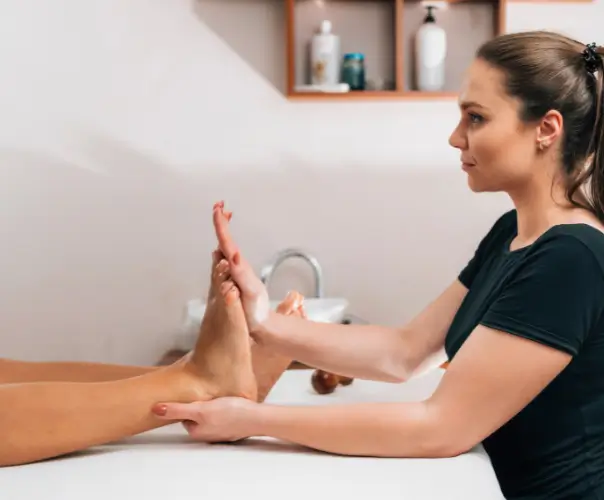August 12, 2025
From burnout to sustainable productivity: 7 proven practices you can adapt to Mexico (with real data)




Actionable lessons from companies in India and global data to transform corporate well-being with a real impact on your P&L. Burnout is not solved with fruit in the office. It is resolved by changing the rules of the game. Here are 7 proven practices and how to implement them in Mexico.
Actionable lessons from companies in India and global data to transform corporate well-being with a real impact on your P&L. Burnout is not solved with fruit in the office. It is resolved by changing the rules of the game. Here are 7 proven practices and how to implement them in Mexico.
Actionable lessons from companies in India and global data to transform corporate well-being with a real impact on your P&L. Burnout is not solved with fruit in the office. It is resolved by changing the rules of the game. Here are 7 proven practices and how to implement them in Mexico.
Actionable lessons from companies in India and global data to transform corporate well-being with a real impact on your P&L. Burnout is not solved with fruit in the office. It is resolved by changing the rules of the game. Here are 7 proven practices and how to implement them in Mexico.
Subscribe to our Newsletter for HR leaders
Workplace wellness strategies, success stories, and corporate promotions directly in your inbox.
Subscribe to our Newsletter for HR leaders
Workplace wellness strategies, success stories, and corporate promotions directly in your inbox.
Subscribe to our Newsletter for HR leaders
Workplace wellness strategies, success stories, and corporate promotions directly in your inbox.
Subscribe to our Newsletter for HR leaders
Workplace wellness strategies, success stories, and corporate promotions directly in your inbox.
Why talking about burnout is talking about business (not perks)
For years, we confused well-being with amenities. The result: big slogans, little traction. Today, the data is stark: global engagement dropped again in 2024 and the loss of productivity associated with demotivation reaches hundreds of billions of dollars; managers are the most affected by the decline in engagement, and almost half haven't received proper training in leadership. These numbers, summarized by Gallup, have raised alarms in executive committees because the impact is no longer reputational; it’s financial.
In parallel, some geographies are experimenting with very specific policies to prevent rather than just react to burnout. In India, for example, companies of various sizes have implemented wellness leaves, organized naps, intentional “digital detox”, and financial education programs. The message is clear: well-being becomes operational, with time, rules, and resources.
In Mexico, we have a regulatory framework pushing in that direction: NOM‑035 requires identifying, analyzing, and preventing psychosocial risks. The opportunity for HR is to move from “minimum compliance” to an integrated strategy that reduces turnover, medical leaves, and presenteeism, and improves business execution.
7 practices that are working (and how to implement them here)
1. Wellness leaves with clear criteria
What it is: Specific days for emotional or mental prevention/recovery, not tied to clinical illness.
Why it works: It addresses the root of burnout before it leads to prolonged leave; it sends a cultural signal of permission to pause. In India, they are already appearing as an explicit policy.
How to implement it in Mexico:
Define operational criteria (notice period, coverage coordination, limits per quarter).
Integrate it into the SIP (safety and health) and the NOM‑035 as a documented preventive measure.
Measure avoidable absenteeism and time until perceived burnout (quarterly surveys).
2. “Power naps” or guided micro-naps
What it is: Breaks of 10–20 minutes at defined intervals, with appropriate spaces.
Why it works: Reduces drowsiness, enhances focus, and decreases errors. In reported pilots, it is accompanied by sleep hygiene norms and clear schedules.
How to implement it in Mexico:
Create a quiet multipurpose room.
Establish rotating shifts so as not to disrupt operations.
Track incidents and recurring errors before/after, and the internal NPS of the program.
3. Intentional “digital detox”
What it is: Windows without email/chat, notification limits, and disconnection rules outside work hours.
Why it works: Reduces compulsive multitasking and protects attention. In India, it is formalized as a written policy.
How to implement it in Mexico:
Set two “deep work” slots without meetings (e.g., 10:00–12:00 and 15:00–16:00).
No urgent message policy after a certain hour except for defined emergencies.
Measure average response time, time in meetings, and project cycle speed.
4. Financial education to reduce economic stress
What it is: Workshops and advice on debt, budget, savings, and unexpected expenses.
Why it works: Financial stress is a trigger for burnout; by reducing it, it improves sleep, concentration, and mood.
How to implement it in Mexico:
Offer micro-modules (30–45 min) + 1:1 advice.
Incentivize goals (savings, debt consolidation) with wellness bonuses.
Align with benefits (payroll, responsible advances) and measure self-reported stress.
5. Real training for managers (not generic “soft skills”)
What it is: Evidence-based training on clear expectations, frequent feedback, coaching, and strengths.
Why it works: Up to 70% of engagement depends on the manager; without training, burnout becomes chronic, especially in younger leadership.
How to implement it in Mexico:
Deploy a curriculum by levels (new leadership, mid-level management, executive).
Measure with a leadership panel: clarity of objectives, 1:1 cadence, recognition, progress.
Link training with OKRs and bonus variables.
6. AI as a “pocket coach,” with ethics and limits
What it is: Assistants that suggest 1:1 agendas, feedback guides, and frameworks for difficult conversations.
Why it works: Scales the quality of management, reduces the cognitive load on the manager. The trend points to “coachbots” that do not replace but rather complement.
How to implement it in Mexico:
Start with narrow use cases (preparing 1:1s, recognition plans, prioritization).
Establish a data policy (confidentiality, biases, no automated decisions).
Measure perceived quality of 1:1s and preparation time.
7. Brief somatic interventions during work hours (on-site massage)
What it is: Structured breaks with chair massage of 10–15 minutes within the office.
Why it works: Reduces muscle tension, improves focus, mood, and reduces perceived stress; furthermore, it sends a powerful cultural message: “health is part of work.”
How to implement it in Mexico:
Integrate it as a monthly session by teams/units.
Prior appointment via corporate email to avoid downtime and measure usage and satisfaction.
Connect data from the session with absenteeism, productivity, and quarterly turnover.
How to justify these measures to your CFO (ROI, not rhetoric)
Your CFO will ask you three questions: How much does it cost? What is avoided? What improves? The answer should come with a simple ROI model:
Direct costs: hours not worked (naps/leaves), fees (massages, training, financial advice), adjustments of spaces.
Savings: reduction of turnover (replacement cost), fewer leaves due to stress, fewer errors, and rework.
Improvements: increase in productivity per hour, shorter cycle times, internal NPS, and eNPS by unit.
Proposed formula: ROI = (Savings + Improvement in attributable margin) – Program costs
Attribution: use control groups (units that have not yet received the intervention) and measure before/after at 90 and 180 days.
Adapting to the Mexican context (NOM‑035 and local realities)
The NOM‑035‑STPS‑2018 requires identifying and preventing psychosocial risks with periodic surveys, preventive measures, and care protocols. Beyond compliance, it is a perfect framework to professionalize well-being: each previous practice can be documented as a preventive measure and related to findings from your internal evaluations (workload, negative leadership, long shifts, etc.).
Additionally, consider:
Segmentation by site/shift: stress is not evenly distributed; plant personnel, back office, and sales live different realities.
Internal communication: an early indicator of success. If people do not understand the “what,” the “why,” and the “how,” the program fails.
Supply chains: critical suppliers with harmful practices also generate stress (constant emergencies, unrealistic deadlines). Incorporate wellness clauses into key contracts.
Typical objections (and effective responses)
“We can't stop production.” It's not about stopping, but about micro-breaks with shifts; data shows fewer errors and greater focus.
“This is expensive.” More expensive is the replacement cost due to turnover and the lost days due to stress. Measure and compare.
“Our culture isn’t like this.” Culture is what you reinforce and finance. Starting small, measuring, and scaling changes culture without rhetoric.
“AI dehumanizes.” Used within limits, it frees up time for the manager for quality human conversations. Ethics and transparency are key.
Where does Zen To Go fit in?
In point 7, we talk about brief somatic interventions that reduce tension and stress during work hours. This is where Zen To Go is a tactical ally: we design office massage sessions (in shiatsu chairs, 10–15 minutes per person) that integrate seamlessly into your operation: scheduling via corporate email, no downtime, usage and satisfaction reports, and recommendations to scale by team. We have been operating in 12 cities for years, with professional therapists and service standards typical of the premium segment. The goal is not to "pamper” but to improve focus, mood, and execution week by week.
The question is not whether your company “believes” in well-being; the question is what you are willing to change to make work a sustainable place. Which practice from the 7 could you pilot in 30 days? Which metric would you move first and with which team would you start?
Why talking about burnout is talking about business (not perks)
For years, we confused well-being with amenities. The result: big slogans, little traction. Today, the data is stark: global engagement dropped again in 2024 and the loss of productivity associated with demotivation reaches hundreds of billions of dollars; managers are the most affected by the decline in engagement, and almost half haven't received proper training in leadership. These numbers, summarized by Gallup, have raised alarms in executive committees because the impact is no longer reputational; it’s financial.
In parallel, some geographies are experimenting with very specific policies to prevent rather than just react to burnout. In India, for example, companies of various sizes have implemented wellness leaves, organized naps, intentional “digital detox”, and financial education programs. The message is clear: well-being becomes operational, with time, rules, and resources.
In Mexico, we have a regulatory framework pushing in that direction: NOM‑035 requires identifying, analyzing, and preventing psychosocial risks. The opportunity for HR is to move from “minimum compliance” to an integrated strategy that reduces turnover, medical leaves, and presenteeism, and improves business execution.
7 practices that are working (and how to implement them here)
1. Wellness leaves with clear criteria
What it is: Specific days for emotional or mental prevention/recovery, not tied to clinical illness.
Why it works: It addresses the root of burnout before it leads to prolonged leave; it sends a cultural signal of permission to pause. In India, they are already appearing as an explicit policy.
How to implement it in Mexico:
Define operational criteria (notice period, coverage coordination, limits per quarter).
Integrate it into the SIP (safety and health) and the NOM‑035 as a documented preventive measure.
Measure avoidable absenteeism and time until perceived burnout (quarterly surveys).
2. “Power naps” or guided micro-naps
What it is: Breaks of 10–20 minutes at defined intervals, with appropriate spaces.
Why it works: Reduces drowsiness, enhances focus, and decreases errors. In reported pilots, it is accompanied by sleep hygiene norms and clear schedules.
How to implement it in Mexico:
Create a quiet multipurpose room.
Establish rotating shifts so as not to disrupt operations.
Track incidents and recurring errors before/after, and the internal NPS of the program.
3. Intentional “digital detox”
What it is: Windows without email/chat, notification limits, and disconnection rules outside work hours.
Why it works: Reduces compulsive multitasking and protects attention. In India, it is formalized as a written policy.
How to implement it in Mexico:
Set two “deep work” slots without meetings (e.g., 10:00–12:00 and 15:00–16:00).
No urgent message policy after a certain hour except for defined emergencies.
Measure average response time, time in meetings, and project cycle speed.
4. Financial education to reduce economic stress
What it is: Workshops and advice on debt, budget, savings, and unexpected expenses.
Why it works: Financial stress is a trigger for burnout; by reducing it, it improves sleep, concentration, and mood.
How to implement it in Mexico:
Offer micro-modules (30–45 min) + 1:1 advice.
Incentivize goals (savings, debt consolidation) with wellness bonuses.
Align with benefits (payroll, responsible advances) and measure self-reported stress.
5. Real training for managers (not generic “soft skills”)
What it is: Evidence-based training on clear expectations, frequent feedback, coaching, and strengths.
Why it works: Up to 70% of engagement depends on the manager; without training, burnout becomes chronic, especially in younger leadership.
How to implement it in Mexico:
Deploy a curriculum by levels (new leadership, mid-level management, executive).
Measure with a leadership panel: clarity of objectives, 1:1 cadence, recognition, progress.
Link training with OKRs and bonus variables.
6. AI as a “pocket coach,” with ethics and limits
What it is: Assistants that suggest 1:1 agendas, feedback guides, and frameworks for difficult conversations.
Why it works: Scales the quality of management, reduces the cognitive load on the manager. The trend points to “coachbots” that do not replace but rather complement.
How to implement it in Mexico:
Start with narrow use cases (preparing 1:1s, recognition plans, prioritization).
Establish a data policy (confidentiality, biases, no automated decisions).
Measure perceived quality of 1:1s and preparation time.
7. Brief somatic interventions during work hours (on-site massage)
What it is: Structured breaks with chair massage of 10–15 minutes within the office.
Why it works: Reduces muscle tension, improves focus, mood, and reduces perceived stress; furthermore, it sends a powerful cultural message: “health is part of work.”
How to implement it in Mexico:
Integrate it as a monthly session by teams/units.
Prior appointment via corporate email to avoid downtime and measure usage and satisfaction.
Connect data from the session with absenteeism, productivity, and quarterly turnover.
How to justify these measures to your CFO (ROI, not rhetoric)
Your CFO will ask you three questions: How much does it cost? What is avoided? What improves? The answer should come with a simple ROI model:
Direct costs: hours not worked (naps/leaves), fees (massages, training, financial advice), adjustments of spaces.
Savings: reduction of turnover (replacement cost), fewer leaves due to stress, fewer errors, and rework.
Improvements: increase in productivity per hour, shorter cycle times, internal NPS, and eNPS by unit.
Proposed formula: ROI = (Savings + Improvement in attributable margin) – Program costs
Attribution: use control groups (units that have not yet received the intervention) and measure before/after at 90 and 180 days.
Adapting to the Mexican context (NOM‑035 and local realities)
The NOM‑035‑STPS‑2018 requires identifying and preventing psychosocial risks with periodic surveys, preventive measures, and care protocols. Beyond compliance, it is a perfect framework to professionalize well-being: each previous practice can be documented as a preventive measure and related to findings from your internal evaluations (workload, negative leadership, long shifts, etc.).
Additionally, consider:
Segmentation by site/shift: stress is not evenly distributed; plant personnel, back office, and sales live different realities.
Internal communication: an early indicator of success. If people do not understand the “what,” the “why,” and the “how,” the program fails.
Supply chains: critical suppliers with harmful practices also generate stress (constant emergencies, unrealistic deadlines). Incorporate wellness clauses into key contracts.
Typical objections (and effective responses)
“We can't stop production.” It's not about stopping, but about micro-breaks with shifts; data shows fewer errors and greater focus.
“This is expensive.” More expensive is the replacement cost due to turnover and the lost days due to stress. Measure and compare.
“Our culture isn’t like this.” Culture is what you reinforce and finance. Starting small, measuring, and scaling changes culture without rhetoric.
“AI dehumanizes.” Used within limits, it frees up time for the manager for quality human conversations. Ethics and transparency are key.
Where does Zen To Go fit in?
In point 7, we talk about brief somatic interventions that reduce tension and stress during work hours. This is where Zen To Go is a tactical ally: we design office massage sessions (in shiatsu chairs, 10–15 minutes per person) that integrate seamlessly into your operation: scheduling via corporate email, no downtime, usage and satisfaction reports, and recommendations to scale by team. We have been operating in 12 cities for years, with professional therapists and service standards typical of the premium segment. The goal is not to "pamper” but to improve focus, mood, and execution week by week.
The question is not whether your company “believes” in well-being; the question is what you are willing to change to make work a sustainable place. Which practice from the 7 could you pilot in 30 days? Which metric would you move first and with which team would you start?
Why talking about burnout is talking about business (not perks)
For years, we confused well-being with amenities. The result: big slogans, little traction. Today, the data is stark: global engagement dropped again in 2024 and the loss of productivity associated with demotivation reaches hundreds of billions of dollars; managers are the most affected by the decline in engagement, and almost half haven't received proper training in leadership. These numbers, summarized by Gallup, have raised alarms in executive committees because the impact is no longer reputational; it’s financial.
In parallel, some geographies are experimenting with very specific policies to prevent rather than just react to burnout. In India, for example, companies of various sizes have implemented wellness leaves, organized naps, intentional “digital detox”, and financial education programs. The message is clear: well-being becomes operational, with time, rules, and resources.
In Mexico, we have a regulatory framework pushing in that direction: NOM‑035 requires identifying, analyzing, and preventing psychosocial risks. The opportunity for HR is to move from “minimum compliance” to an integrated strategy that reduces turnover, medical leaves, and presenteeism, and improves business execution.
7 practices that are working (and how to implement them here)
1. Wellness leaves with clear criteria
What it is: Specific days for emotional or mental prevention/recovery, not tied to clinical illness.
Why it works: It addresses the root of burnout before it leads to prolonged leave; it sends a cultural signal of permission to pause. In India, they are already appearing as an explicit policy.
How to implement it in Mexico:
Define operational criteria (notice period, coverage coordination, limits per quarter).
Integrate it into the SIP (safety and health) and the NOM‑035 as a documented preventive measure.
Measure avoidable absenteeism and time until perceived burnout (quarterly surveys).
2. “Power naps” or guided micro-naps
What it is: Breaks of 10–20 minutes at defined intervals, with appropriate spaces.
Why it works: Reduces drowsiness, enhances focus, and decreases errors. In reported pilots, it is accompanied by sleep hygiene norms and clear schedules.
How to implement it in Mexico:
Create a quiet multipurpose room.
Establish rotating shifts so as not to disrupt operations.
Track incidents and recurring errors before/after, and the internal NPS of the program.
3. Intentional “digital detox”
What it is: Windows without email/chat, notification limits, and disconnection rules outside work hours.
Why it works: Reduces compulsive multitasking and protects attention. In India, it is formalized as a written policy.
How to implement it in Mexico:
Set two “deep work” slots without meetings (e.g., 10:00–12:00 and 15:00–16:00).
No urgent message policy after a certain hour except for defined emergencies.
Measure average response time, time in meetings, and project cycle speed.
4. Financial education to reduce economic stress
What it is: Workshops and advice on debt, budget, savings, and unexpected expenses.
Why it works: Financial stress is a trigger for burnout; by reducing it, it improves sleep, concentration, and mood.
How to implement it in Mexico:
Offer micro-modules (30–45 min) + 1:1 advice.
Incentivize goals (savings, debt consolidation) with wellness bonuses.
Align with benefits (payroll, responsible advances) and measure self-reported stress.
5. Real training for managers (not generic “soft skills”)
What it is: Evidence-based training on clear expectations, frequent feedback, coaching, and strengths.
Why it works: Up to 70% of engagement depends on the manager; without training, burnout becomes chronic, especially in younger leadership.
How to implement it in Mexico:
Deploy a curriculum by levels (new leadership, mid-level management, executive).
Measure with a leadership panel: clarity of objectives, 1:1 cadence, recognition, progress.
Link training with OKRs and bonus variables.
6. AI as a “pocket coach,” with ethics and limits
What it is: Assistants that suggest 1:1 agendas, feedback guides, and frameworks for difficult conversations.
Why it works: Scales the quality of management, reduces the cognitive load on the manager. The trend points to “coachbots” that do not replace but rather complement.
How to implement it in Mexico:
Start with narrow use cases (preparing 1:1s, recognition plans, prioritization).
Establish a data policy (confidentiality, biases, no automated decisions).
Measure perceived quality of 1:1s and preparation time.
7. Brief somatic interventions during work hours (on-site massage)
What it is: Structured breaks with chair massage of 10–15 minutes within the office.
Why it works: Reduces muscle tension, improves focus, mood, and reduces perceived stress; furthermore, it sends a powerful cultural message: “health is part of work.”
How to implement it in Mexico:
Integrate it as a monthly session by teams/units.
Prior appointment via corporate email to avoid downtime and measure usage and satisfaction.
Connect data from the session with absenteeism, productivity, and quarterly turnover.
How to justify these measures to your CFO (ROI, not rhetoric)
Your CFO will ask you three questions: How much does it cost? What is avoided? What improves? The answer should come with a simple ROI model:
Direct costs: hours not worked (naps/leaves), fees (massages, training, financial advice), adjustments of spaces.
Savings: reduction of turnover (replacement cost), fewer leaves due to stress, fewer errors, and rework.
Improvements: increase in productivity per hour, shorter cycle times, internal NPS, and eNPS by unit.
Proposed formula: ROI = (Savings + Improvement in attributable margin) – Program costs
Attribution: use control groups (units that have not yet received the intervention) and measure before/after at 90 and 180 days.
Adapting to the Mexican context (NOM‑035 and local realities)
The NOM‑035‑STPS‑2018 requires identifying and preventing psychosocial risks with periodic surveys, preventive measures, and care protocols. Beyond compliance, it is a perfect framework to professionalize well-being: each previous practice can be documented as a preventive measure and related to findings from your internal evaluations (workload, negative leadership, long shifts, etc.).
Additionally, consider:
Segmentation by site/shift: stress is not evenly distributed; plant personnel, back office, and sales live different realities.
Internal communication: an early indicator of success. If people do not understand the “what,” the “why,” and the “how,” the program fails.
Supply chains: critical suppliers with harmful practices also generate stress (constant emergencies, unrealistic deadlines). Incorporate wellness clauses into key contracts.
Typical objections (and effective responses)
“We can't stop production.” It's not about stopping, but about micro-breaks with shifts; data shows fewer errors and greater focus.
“This is expensive.” More expensive is the replacement cost due to turnover and the lost days due to stress. Measure and compare.
“Our culture isn’t like this.” Culture is what you reinforce and finance. Starting small, measuring, and scaling changes culture without rhetoric.
“AI dehumanizes.” Used within limits, it frees up time for the manager for quality human conversations. Ethics and transparency are key.
Where does Zen To Go fit in?
In point 7, we talk about brief somatic interventions that reduce tension and stress during work hours. This is where Zen To Go is a tactical ally: we design office massage sessions (in shiatsu chairs, 10–15 minutes per person) that integrate seamlessly into your operation: scheduling via corporate email, no downtime, usage and satisfaction reports, and recommendations to scale by team. We have been operating in 12 cities for years, with professional therapists and service standards typical of the premium segment. The goal is not to "pamper” but to improve focus, mood, and execution week by week.
The question is not whether your company “believes” in well-being; the question is what you are willing to change to make work a sustainable place. Which practice from the 7 could you pilot in 30 days? Which metric would you move first and with which team would you start?
Why talking about burnout is talking about business (not perks)
For years, we confused well-being with amenities. The result: big slogans, little traction. Today, the data is stark: global engagement dropped again in 2024 and the loss of productivity associated with demotivation reaches hundreds of billions of dollars; managers are the most affected by the decline in engagement, and almost half haven't received proper training in leadership. These numbers, summarized by Gallup, have raised alarms in executive committees because the impact is no longer reputational; it’s financial.
In parallel, some geographies are experimenting with very specific policies to prevent rather than just react to burnout. In India, for example, companies of various sizes have implemented wellness leaves, organized naps, intentional “digital detox”, and financial education programs. The message is clear: well-being becomes operational, with time, rules, and resources.
In Mexico, we have a regulatory framework pushing in that direction: NOM‑035 requires identifying, analyzing, and preventing psychosocial risks. The opportunity for HR is to move from “minimum compliance” to an integrated strategy that reduces turnover, medical leaves, and presenteeism, and improves business execution.
7 practices that are working (and how to implement them here)
1. Wellness leaves with clear criteria
What it is: Specific days for emotional or mental prevention/recovery, not tied to clinical illness.
Why it works: It addresses the root of burnout before it leads to prolonged leave; it sends a cultural signal of permission to pause. In India, they are already appearing as an explicit policy.
How to implement it in Mexico:
Define operational criteria (notice period, coverage coordination, limits per quarter).
Integrate it into the SIP (safety and health) and the NOM‑035 as a documented preventive measure.
Measure avoidable absenteeism and time until perceived burnout (quarterly surveys).
2. “Power naps” or guided micro-naps
What it is: Breaks of 10–20 minutes at defined intervals, with appropriate spaces.
Why it works: Reduces drowsiness, enhances focus, and decreases errors. In reported pilots, it is accompanied by sleep hygiene norms and clear schedules.
How to implement it in Mexico:
Create a quiet multipurpose room.
Establish rotating shifts so as not to disrupt operations.
Track incidents and recurring errors before/after, and the internal NPS of the program.
3. Intentional “digital detox”
What it is: Windows without email/chat, notification limits, and disconnection rules outside work hours.
Why it works: Reduces compulsive multitasking and protects attention. In India, it is formalized as a written policy.
How to implement it in Mexico:
Set two “deep work” slots without meetings (e.g., 10:00–12:00 and 15:00–16:00).
No urgent message policy after a certain hour except for defined emergencies.
Measure average response time, time in meetings, and project cycle speed.
4. Financial education to reduce economic stress
What it is: Workshops and advice on debt, budget, savings, and unexpected expenses.
Why it works: Financial stress is a trigger for burnout; by reducing it, it improves sleep, concentration, and mood.
How to implement it in Mexico:
Offer micro-modules (30–45 min) + 1:1 advice.
Incentivize goals (savings, debt consolidation) with wellness bonuses.
Align with benefits (payroll, responsible advances) and measure self-reported stress.
5. Real training for managers (not generic “soft skills”)
What it is: Evidence-based training on clear expectations, frequent feedback, coaching, and strengths.
Why it works: Up to 70% of engagement depends on the manager; without training, burnout becomes chronic, especially in younger leadership.
How to implement it in Mexico:
Deploy a curriculum by levels (new leadership, mid-level management, executive).
Measure with a leadership panel: clarity of objectives, 1:1 cadence, recognition, progress.
Link training with OKRs and bonus variables.
6. AI as a “pocket coach,” with ethics and limits
What it is: Assistants that suggest 1:1 agendas, feedback guides, and frameworks for difficult conversations.
Why it works: Scales the quality of management, reduces the cognitive load on the manager. The trend points to “coachbots” that do not replace but rather complement.
How to implement it in Mexico:
Start with narrow use cases (preparing 1:1s, recognition plans, prioritization).
Establish a data policy (confidentiality, biases, no automated decisions).
Measure perceived quality of 1:1s and preparation time.
7. Brief somatic interventions during work hours (on-site massage)
What it is: Structured breaks with chair massage of 10–15 minutes within the office.
Why it works: Reduces muscle tension, improves focus, mood, and reduces perceived stress; furthermore, it sends a powerful cultural message: “health is part of work.”
How to implement it in Mexico:
Integrate it as a monthly session by teams/units.
Prior appointment via corporate email to avoid downtime and measure usage and satisfaction.
Connect data from the session with absenteeism, productivity, and quarterly turnover.
How to justify these measures to your CFO (ROI, not rhetoric)
Your CFO will ask you three questions: How much does it cost? What is avoided? What improves? The answer should come with a simple ROI model:
Direct costs: hours not worked (naps/leaves), fees (massages, training, financial advice), adjustments of spaces.
Savings: reduction of turnover (replacement cost), fewer leaves due to stress, fewer errors, and rework.
Improvements: increase in productivity per hour, shorter cycle times, internal NPS, and eNPS by unit.
Proposed formula: ROI = (Savings + Improvement in attributable margin) – Program costs
Attribution: use control groups (units that have not yet received the intervention) and measure before/after at 90 and 180 days.
Adapting to the Mexican context (NOM‑035 and local realities)
The NOM‑035‑STPS‑2018 requires identifying and preventing psychosocial risks with periodic surveys, preventive measures, and care protocols. Beyond compliance, it is a perfect framework to professionalize well-being: each previous practice can be documented as a preventive measure and related to findings from your internal evaluations (workload, negative leadership, long shifts, etc.).
Additionally, consider:
Segmentation by site/shift: stress is not evenly distributed; plant personnel, back office, and sales live different realities.
Internal communication: an early indicator of success. If people do not understand the “what,” the “why,” and the “how,” the program fails.
Supply chains: critical suppliers with harmful practices also generate stress (constant emergencies, unrealistic deadlines). Incorporate wellness clauses into key contracts.
Typical objections (and effective responses)
“We can't stop production.” It's not about stopping, but about micro-breaks with shifts; data shows fewer errors and greater focus.
“This is expensive.” More expensive is the replacement cost due to turnover and the lost days due to stress. Measure and compare.
“Our culture isn’t like this.” Culture is what you reinforce and finance. Starting small, measuring, and scaling changes culture without rhetoric.
“AI dehumanizes.” Used within limits, it frees up time for the manager for quality human conversations. Ethics and transparency are key.
Where does Zen To Go fit in?
In point 7, we talk about brief somatic interventions that reduce tension and stress during work hours. This is where Zen To Go is a tactical ally: we design office massage sessions (in shiatsu chairs, 10–15 minutes per person) that integrate seamlessly into your operation: scheduling via corporate email, no downtime, usage and satisfaction reports, and recommendations to scale by team. We have been operating in 12 cities for years, with professional therapists and service standards typical of the premium segment. The goal is not to "pamper” but to improve focus, mood, and execution week by week.
The question is not whether your company “believes” in well-being; the question is what you are willing to change to make work a sustainable place. Which practice from the 7 could you pilot in 30 days? Which metric would you move first and with which team would you start?
You may also be interested in
Discover Our Home Services
💆 Massages and facials at home in various cities in Mexico 🌟

Swedish Massage
The relaxing massage combines gentle movements to release tension and calm the body and mind.

Deep Tissue Massage
Deep tissue massage uses firm pressure and slow techniques to work on the deeper layers of muscle.

Sports Massage
Sports massage combines specialized techniques to prevent injuries, relieve tension, and optimize muscle recovery.

Lymphatic Drainage Massage
Lymphatic drainage massage uses gentle, rhythmic movements to stimulate the lymphatic system, reduce fluid retention, and detoxify the body.

Prenatal Massage
Prenatal massage relieves tension, reduces swelling, and improves the well-being of both the mother and the baby using safe techniques adapted for pregnancy.

Reflexology
Reflexology uses the stimulation of specific points to promote relaxation, improve circulation, and balance overall well-being.

Couples Massage
Custom pressure for each. Ideal for couples looking to reduce stress and enjoy well-being at home.

Fiesta SPA
Experience an unforgettable time with massages and facials, perfect for relaxing with your friends at your spa party or event.
Discover Our Home Services
💆 Massages and facials at home in various cities in Mexico 🌟

Swedish Massage
The relaxing massage combines gentle movements to release tension and calm the body and mind.

Deep Tissue Massage
Deep tissue massage uses firm pressure and slow techniques to work on the deeper layers of muscle.

Sports Massage
Sports massage combines specialized techniques to prevent injuries, relieve tension, and optimize muscle recovery.

Lymphatic Drainage Massage
Lymphatic drainage massage uses gentle, rhythmic movements to stimulate the lymphatic system, reduce fluid retention, and detoxify the body.

Prenatal Massage
Prenatal massage relieves tension, reduces swelling, and improves the well-being of both the mother and the baby using safe techniques adapted for pregnancy.

Reflexology
Reflexology uses the stimulation of specific points to promote relaxation, improve circulation, and balance overall well-being.

Couples Massage
Custom pressure for each. Ideal for couples looking to reduce stress and enjoy well-being at home.

Fiesta SPA
Experience an unforgettable time with massages and facials, perfect for relaxing with your friends at your spa party or event.
Discover Our Home Services
💆 Massages and facials at home in various cities in Mexico 🌟

Swedish Massage
The relaxing massage combines gentle movements to release tension and calm the body and mind.

Deep Tissue Massage
Deep tissue massage uses firm pressure and slow techniques to work on the deeper layers of muscle.

Sports Massage
Sports massage combines specialized techniques to prevent injuries, relieve tension, and optimize muscle recovery.

Lymphatic Drainage Massage
Lymphatic drainage massage uses gentle, rhythmic movements to stimulate the lymphatic system, reduce fluid retention, and detoxify the body.

Prenatal Massage
Prenatal massage relieves tension, reduces swelling, and improves the well-being of both the mother and the baby using safe techniques adapted for pregnancy.

Reflexology
Reflexology uses the stimulation of specific points to promote relaxation, improve circulation, and balance overall well-being.

Couples Massage
Custom pressure for each. Ideal for couples looking to reduce stress and enjoy well-being at home.

Fiesta SPA
Experience an unforgettable time with massages and facials, perfect for relaxing with your friends at your spa party or event.
Discover Our Home Services
💆 Massages and facials at home in various cities in Mexico 🌟

Swedish Massage
The relaxing massage combines gentle movements to release tension and calm the body and mind.

Deep Tissue Massage
Deep tissue massage uses firm pressure and slow techniques to work on the deeper layers of muscle.

Sports Massage
Sports massage combines specialized techniques to prevent injuries, relieve tension, and optimize muscle recovery.

Lymphatic Drainage Massage
Lymphatic drainage massage uses gentle, rhythmic movements to stimulate the lymphatic system, reduce fluid retention, and detoxify the body.

Prenatal Massage
Prenatal massage relieves tension, reduces swelling, and improves the well-being of both the mother and the baby using safe techniques adapted for pregnancy.

Reflexology
Reflexology uses the stimulation of specific points to promote relaxation, improve circulation, and balance overall well-being.

Couples Massage
Custom pressure for each. Ideal for couples looking to reduce stress and enjoy well-being at home.

Fiesta SPA
Experience an unforgettable time with massages and facials, perfect for relaxing with your friends at your spa party or event.
Schedule My Home Massage
Our customer service often exceeds expectations, providing an unmatched experience.
Certified therapists from the best SPAs in the city
No penalties if you cancel 24 hours before your service.
7 out of 10 local customers return and become frequent customers.
Schedule My Home Massage
Our customer service often exceeds expectations, providing an unmatched experience.
Certified therapists from the best SPAs in the city
No penalties if you cancel 24 hours before your service.
7 out of 10 local customers return and become frequent customers.
Schedule My Home Massage
Our customer service often exceeds expectations, providing an unmatched experience.
Certified therapists from the best SPAs in the city
No penalties if you cancel 24 hours before your service.
7 out of 10 local customers return and become frequent customers.
Schedule My Home Massage
Our customer service often exceeds expectations, providing an unmatched experience.
Certified therapists from the best SPAs in the city
No penalties if you cancel 24 hours before your service.
7 out of 10 local customers return and become frequent customers.

We are Home Wellness. We connect you with the best therapists in the city conveniently and securely, so you can say goodbye to stress.
Contact us via your preferred channel:
Work with us
Services
© 2019-2025 Zen to Go™. All rights reserved. Zen to Go is a registered trademark of Plataformas Zen México SA de CV.
Calle 38 Entre Av. 10 y 10 BIS, Local 12, Zazil-Ha, Playa del Carmen, Quintana Roo, CP 77720, México.

We are Home Wellness. We connect you with the best therapists in the city conveniently and securely, so you can say goodbye to stress.
Contact us via your preferred channel:
Work with us
Services
© 2019-2025 Zen to Go™. All rights reserved. Zen to Go is a registered trademark of Plataformas Zen México SA de CV.
Calle 38 Entre Av. 10 y 10 BIS, Local 12, Zazil-Ha, Playa del Carmen, Quintana Roo, CP 77720, México.

We are Home Wellness. We connect you with the best therapists in the city conveniently and securely, so you can say goodbye to stress.
Contact us via your preferred channel:
Work with us
Services
© 2019-2025 Zen to Go™. All rights reserved. Zen to Go is a registered trademark of Plataformas Zen México SA de CV.
Calle 38 Entre Av. 10 y 10 BIS, Local 12, Zazil-Ha, Playa del Carmen, Quintana Roo, CP 77720, México.

We are Home Wellness. We connect you with the best therapists in the city conveniently and securely, so you can say goodbye to stress.
Contact us via your preferred channel:
Work with us
Services
© 2019-2025 Zen to Go™. All rights reserved. Zen to Go is a registered trademark of Plataformas Zen México SA de CV.
Calle 38 Entre Av. 10 y 10 BIS, Local 12, Zazil-Ha, Playa del Carmen, Quintana Roo, CP 77720, México.



